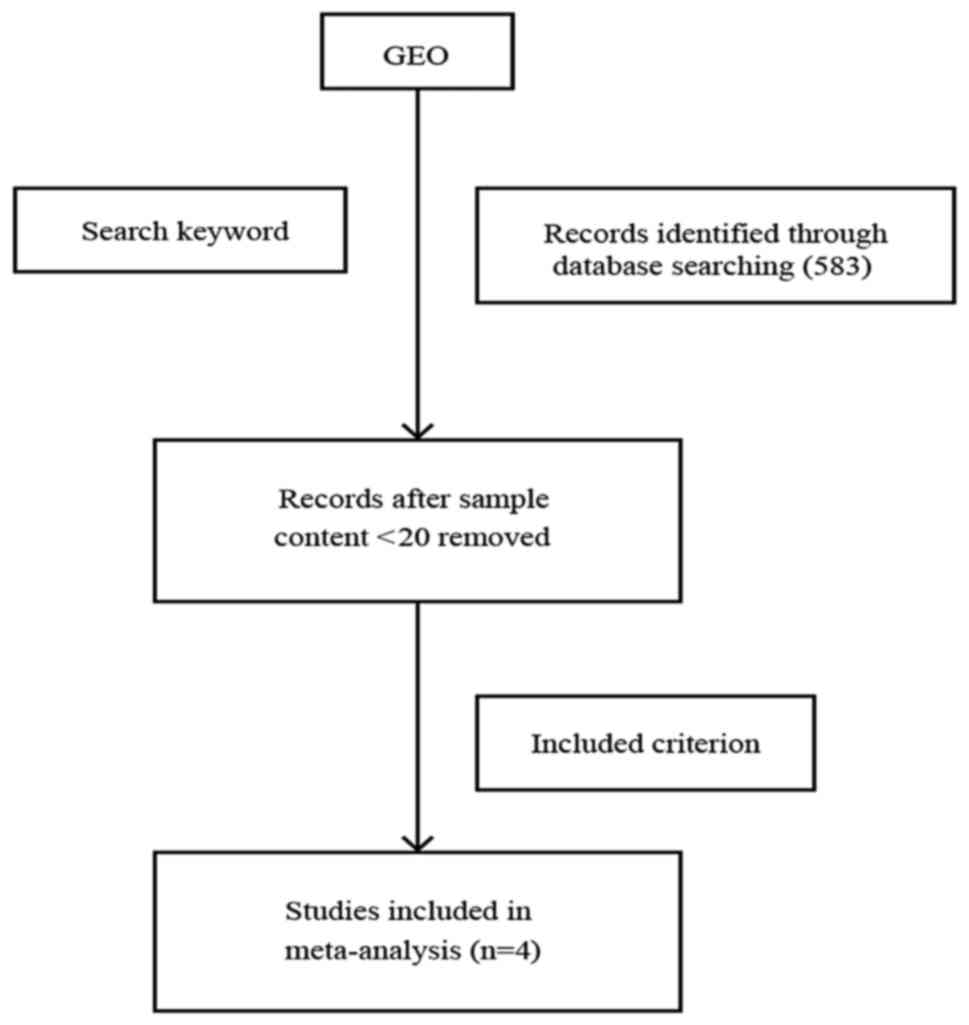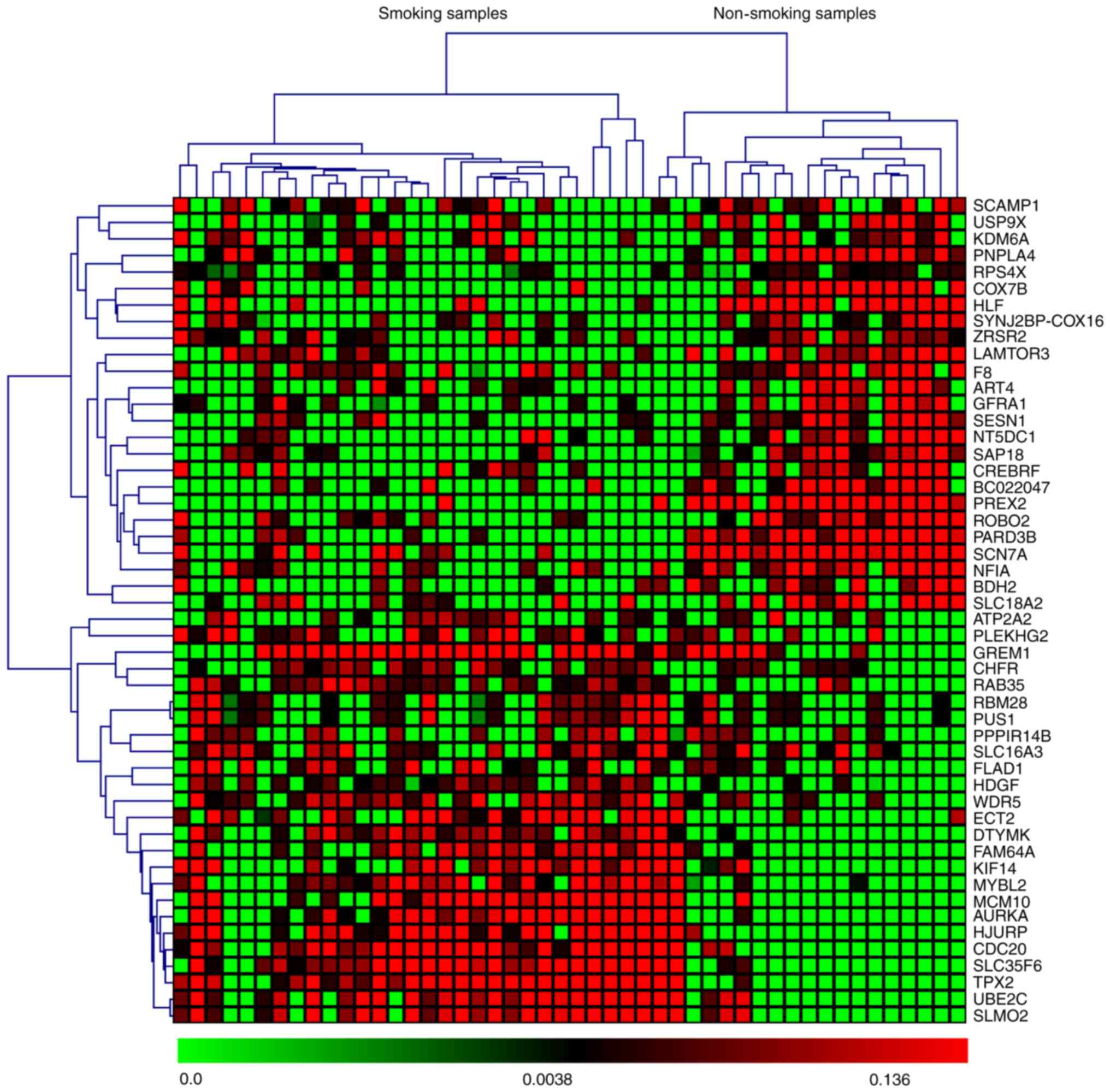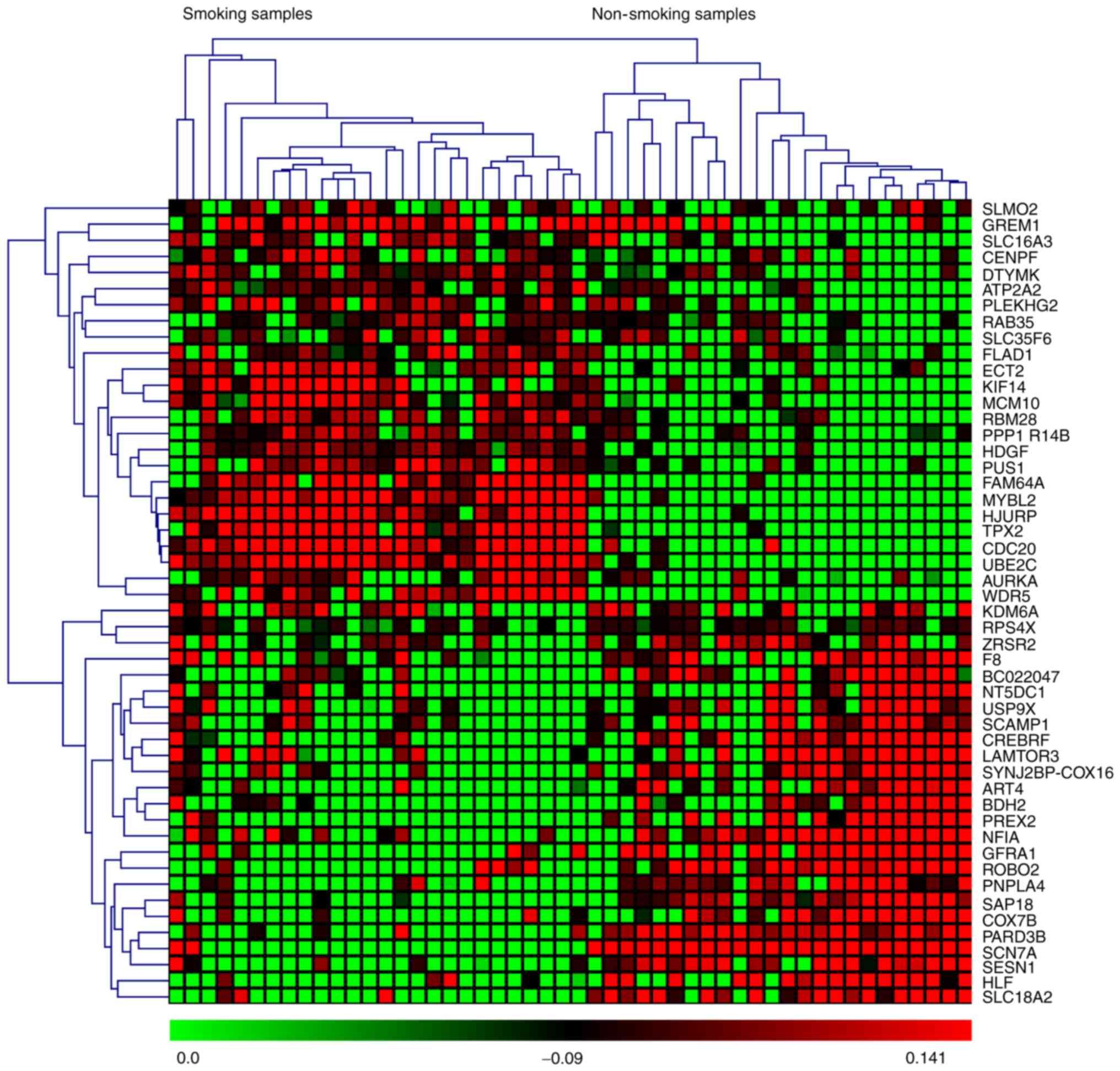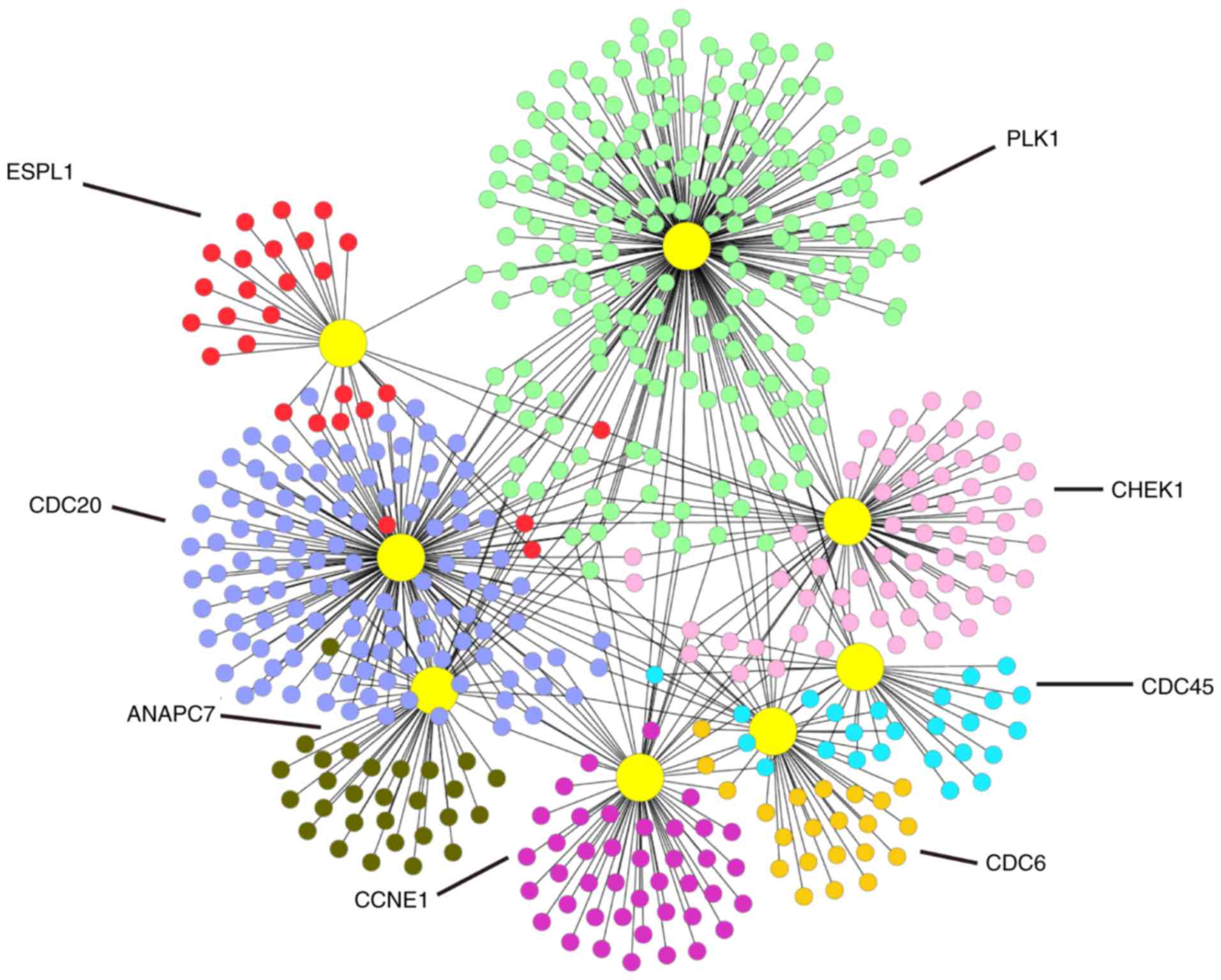Meta-analysis of mRNA expression profiles to identify differentially expressed genes in lung adenocarcinoma tissue from smokers and non-smokers
- Authors:
- Published online on: January 8, 2018 https://doi.org/10.3892/or.2018.6197
- Pages: 929-938
-
Copyright: © He et al. This is an open access article distributed under the terms of Creative Commons Attribution License.
Abstract
Introduction
Lung cancer is one of the most common types of cancer and is the leading cause of cancer-related mortality wordwide. Small cell lung cancer (SCLC) and non-small cell lung cancer (NSCLC) are the most common types of lung cancer, of which NSCLC accounts for approximately 85% of all cases (1). Lung adenocarcinoma is the most common subtype of NSCLC (40%) in many countries (2,3). To date, many genetic factors have been proposed to be involved in lung adenocarcinoma, including several tumour-suppressor genes (TP53, CDKN2A, STK11, NF1, ATM, RB1, and APC) (4,5). Several new targeted therapies have resulted in considerable clinical benefits for cancer patients in recent years, as well as a deeper understanding of lung adenocarcinoma at the molecular level. One example of a new targeted therapy is epidermal growth factor receptor (EGFR) and KRAS targeted gene therapy (6,7). However, targeted gene therapy is mainly used when patients have special characteristics. EGFR mutations occur more frequently in female lung adenocarcinoma patients with a non-smoking history (8). HER2 mutations tend to occur in non-smoking males (9). In contrast, KRAS mutations occur during the early development of smoking-related lung adenocarcinoma (10). Based on these observations, there is a need to develop individualized treatment programs for patients with unique clinical characteristics. Lung adenocarcinoma is caused by a combination of genetic and environmental effects (11).
More recently, the incidence of lung adenocarcinoma has increased in smokers (12). Tobacco smoke contains a mixture of harmful compounds and carcinogens (13). Therefore, smoking plays an important role in the development of lung adenocarcinoma. Although the correlation between smoking and lung adenocarcinoma has been demonstrated in previous studies, a meta-analysis of the gene mutations in a large number of tissue samples that considers the smoking history in lung adenocarcinoma has not yet been conducted (14). This large scale analysis can reduce the differences caused by different research conditions and can integrate the results from previous studies to evaluate the issue from another point of view. The development of microarray methods for large scale analysis of gene expression makes it possible to perform a more comprehensive analysis for potential genes and molecular pathways associated with lung adenocarcinoma in smoking patients (15). DNA microarray analysis has been applied to investigate whole genomic expression profiles and physiological mechanisms in health and disease (16,17). Therefore, a high-throughput microarray experiment was designed to analyse the genetic expression patterns and identify potential genes to target for lung adenocarcinoma (18). Meta-analysis provides a powerful tool for analysing microarray experiments by combining data from multiple studies (19). Genes identified by meta-analysis tend to overlap with genes identified in other studies, suggesting increased reliability (20). In addition to providing a new perspective, this research topic will further the understanding of the relationship between smoking and lung adenocarcinoma.
The aim of this study was to identify possible candidate genes for personalized treatment for lung adenocarcinoma patients with a history of smoking to provide patients with better treatment options and ensure a good prognosis. Therefore, we conducted a meta-analysis using the same platform of gene expression profile data that associated smoking with lung adenocarcinoma tissue.
Materials and methods
Selection of microarray datasets for meta-analysis
According to the Preferred Reporting Items for Systematic Reviews and Meta-Analysis (PRISMA) guidelines published in 2009, we performed a detailed and comprehensive search of microarray datasets in the Gene Expression Omnibus (GEO) database of the National Center for Biotechnology Information (NCBI) (http://www.ncbi.nlm.nih.gov/geo/).
Meta-analysis data
To maintain objectivity, the data were simultaneously extracted by two independent reviewers from the original search. Any discrepancies that arose between the two reviewers were resolved by consultation with a third reviewer. The terms ‘lung neoplasms’ and ‘lung cancer’ were considered keywords during our search for this study. In addition, studies that reported non-human data were excluded in the selection process for microarray datasets. Finally, 583 datasets were obtained from searching the Gene Expression Omnibus (GEO) database. Datasets with >20,288 samples were elected for the study. We included a dataset in the meta-analysis if it contained i) all samples on the Affymetrix Human Genome U133 Plus 2.0 Array platform, ii) samples from lung adenocarcinoma tissue and iii) samples with valid smoking statuses. According to the criteria, the four datasets that were selected from the 288 datasets included 477 lung adenocarcinoma tissues with valid smoking statuses. Then, we downloaded the lung adenocarcinoma tissue files (CEL) of the four microarray datasets from the GEO database with accession numbers GSE12667, GSE31210, GSE40791, and GSE50081. The four datasets included 477 lung adenocarcinoma patients; 327 of which were smokers, and 150 were non-smokers; the smokers included former smokers, current smokers and ex-smokers.
Meta-analysis of microarray datasets using the same platform
We conducted the meta-analysis of gene expression profiles of the selected four microarray datasets by using R statistical software (http://www.r-project.org/) with the same platform. Prior to the meta-analysis, we performed data normalization of the four datasets using R statistical software. Then, we processed the meta-analysis using the MAMA, mataMA, affyPLM and CLL packages in R statistical software according to the t-test and z-score methods. During the meta-analysis with R statistical software, a list of differentially expressed genes (DEGs) (upregulated or downregulated) were identified based on the P-values (where the threshold was <0.005) and z-scores (where the threshold was an absolute value >3).
Enrichment analysis of the GO function and KEGG pathway
It is important to understand the biological implications of the identified DEGs in lung adenocarcinoma tissue. According to the meta-analysis results, the most significant 200 DEGs (100 upregulated and 100 downregulated) were selected for enrichment analysis. Then, we conducted the functional enrichment analysis of the gene ontology (GO) function and the Kyoto Encyclopedia of Genes and Genomes (KEGG) pathway using the WEB-based GEne SeT AnaLysis Toolkit (http://bioinfo.vanderbilt.edu/webgestalt/login.php) under a significance threshold of P<0.05.
PPI network analysis
To further understand and predict the biological activity of the identified DEGs that were based on the results of the GO function and KEGG pathway enrichment analyses, we conducted a protein-protein interaction (PPI) network using the Cytoscape software. Prior to this analysis, we imported the DEG-encoding proteins into a protein-protein interaction (PPI) network, which was downloaded from the Biological General Repository for Interaction Datasets (BioGRID, http://thebiogrid.org/).
Results
Selection of microarray datasets related to lung adenocarcinoma for meta-analysis
From the microarray datasets retrieved from the GEO database of NCBI, we extracted 477 GEO lung adenocarcinoma samples that belonged to four microarray datasets, which met our criteria for meta-analysis (see Materials and methods, and Fig. 1). All four GEO series (GSEs) were microarray datasets that used only lung adenocarcinoma tissue with valid smoking statuses. The GEO Platform Files (GPLs) from the four datasets (GSE12667, GSE31210, GSE40791 and GSE50081) were obtained using the Affymetrix ‘Gene Chip’ (Table I).
Table I.Characteristic of individual studies retrieved from Gene Expression Omnibus for meta-analysis. |
Identification of upregulated or downregulated DEGs through meta-analysis
We performed the meta-analysis of gene expression profiles according to t-test and z-score methods using MAMA, mataMA, affyPLM and CLL packages in R statistical software on the same platform. According to the P-value (where the threshold was <0.005) and z-score (where the threshold was an absolute value >3), we were able to identify a total of 2,932 DEGs, including 1,806 upregulated and 1,126 downregulated genes using Venny 2.0 (http://bioinfogp.cnb.csic.es/tools/venny/index.html). The 200 genes that showed maximum upregulation and downregulation are shown in Tables II and III, and the overlapping DEGs based on P-values and z-scores are shown in Fig. 2. A subset of the top 50 DEGs (25 upregulated and 25 downregulated) in the four microarray datasets were visualized with heat maps using the Mev software and are shown in Figs. 3–6.
Enrichment analysis of the GO function and KEGG pathway for the top 100 upregulated and downregulated DEGs
We classified the 200 DEGs that were identified through meta-analysis according to the GO hierarchy into functional categories (biological process, molecular function, and cellular component) and based on the KEGG pathway, with a significance threshold of <0.05. The most significant GO terms under the biological processes category were enriched in the following descending order: ‘cell cycle phase’ (GO:0022403), ‘M phase of mitotic cell cycle’ (GO:0000087) and ‘mitotic cell cycle’ (GO:0000278). The most enriched GO terms under the molecular functions and cellular components categories were ‘protein binding’ (GO:0005515) and ‘nuclear part’ (GO:0044428). The most enriched KEGG pathway terms were (in descending order): ‘Cell cycle’ (kegg:04110), ‘Oocyte meiosis’ (kegg:04114) and ‘Ubiquitin mediated proteolysis’ (kegg:04120) (Tables IV and V).
Table IV.The enrichment based on the top 10 GO functions shows the top 100 upregulated and downregulated DEGs. |
Table V.The enrichment based on the top KEGG pathway shows the top 100 upregulated and downregulated DEGs. |
PPI network analysis of the DEGs
To understand the biological meaning of the 8 upregulated DEGs identified by the KEGG pathway under the cell cycle pathway at the protein level, we constructed a PPI network for the proteins encoded by the 8 DEGs with interactions that included 541 nodes and 671 edges as shown in Fig. 7.
Discussion
In the present study, we showed that genes are differentially expressed in lung adenocarcinoma in smoking and non-smoking patients. Some genes that showed the highest expression levels were found in lung adenocarcinoma patients who had a smoking history. Smoking consistently plays an important role in the development of lung adenocarcinoma. Cigarette smoke contains over 400 identified chemicals, at least 250 of which are implicated in tumour initiation and promotion (21). It is estimated that more than 50 chemicals in tobacco smoke cause cancers (22). Cigarette smoke is by far the most widespread link between exposure to known carcinogens and death from lung cancer (23). Lung adenocarcinoma is one of the main types of lung cancer in smokers and cannot be successfully treated with traditional treatments. Therefore, the effects of cigarette smoke on the genes that are implicated in lung adenocarcinoma are critical to increase our understanding of the carcinogenesis and in finding targeted genes. In our study, we found that the cell cycle pathway was significantly altered in lung adenocarcinoma tissues from patients with a smoking history.
Using several perspectives would allow us to characterise the underlying mechanisms of lung adenocarcinoma in smokers. Thus, we performed a meta-analysis of four independent microarray datasets using the same platform. The large number of DEGs identified in our study implies that our approach produces more reliable results in identifying differences in gene expression levels among lung adenocarcinoma patients who either had a smoking or a non-smoking history. In this study, the microarray expression datasets derived from lung adenocarcinoma tissue with patients with either a smoking or non-smoking history were publicly available. A number of previous studies have molecularly characterised the genetic profiles in lung cancer patients with or without a smoking history. The present investigation focused on a relatively larger cohort with 477 lung adenocarcinoma tissues from 327 smoking patients and 150 non-smoking patients, thereby providing a more powerful analysis. Our study results were highly consistent with previous DEG analyses, supporting the utility and validity of this analytical approach. Additionally, it also revealed that multiple biological processes and pathways, including cell cycle phase and the cell cycle pathway, were significantly affected in lung adenocarcinoma tissues from smoking patients compared to the non-smoking patients. Consistently, many previous studies have revealed that cigarette smoke extract accelerated premature gene mutations in the cell cycle pathway. Cigarette smoke extract alters the cell cycle via the phospholipid transfer protein/transforming growth factor-β1/cyclinD1/CDK4 pathway (24). Cigarette smoking is a major factor for many cancers including, pancreatic cancer, human ovarian cancer and colon cancer (25–27). This study identified the 8 overexpressed genes in the cell cycle pathway as CDC45, PLK1, CDC20, ANAPC7, CDC6, CHEK1, CCNE1 and ESPL1. According to the P-values in the meta-analysis, we identified a few significant DEGs including CDC45, CDC20, ANAPC7, CDC6, and ESPL1. Based on our meta-analysis results, these five genes may be potential target genes for the treatment of this disease.
CDC45 is a member of the highly conserved multiprotein complex including Cdc6/Cdc18. The replication factor CDC45 has essential functions in the initiation and plays an important role in the intra-S-phase checkpoint (28). CDC45 has been found to be upregulated in many neoplasms, such as breast neoplasms, colorectal neoplasms, lung neoplasms and haematological neoplasms (29).
CDC20 appears to act as a regulatory protein by interacting with several other proteins at multiple points in the cell cycle (30). The CDC20 gene might play an important role in the malignancy of NSCLC. Additionally, CDC20 has been found to be upregulated in lung cancer patients with a smoking history (31). In addition, through this analysis, we identified the overexpression of the CDC20 gene in lung adenocarcinoma patients who had a smoking history compared to the non-smoking patients. Combined with previous research, our analysis demonstrates that the CDC20 gene might play an important role in the treatment of lung adenocarcinoma in smoking patients.
ANAPC7 is an E3 ligase enzyme that ubiquinates various proteins involved in the cell cycle (32). This protein complex may have a pivotal role in the cell cycle control affecting pathological conditions such as cancer (33). ANAPC mutations have been reported in lung squamous cell carcinoma and small cell lung carcinoma.
CDC6, a cell cycle regulatory gene, is an essential regulator of DNA replication and plays important roles in the activation and maintenance of the checkpoint mechanism in the cell cycle (34). CDC6 has been associated with the oncogenic activities in human cancers, such as ovarian cancer, lung cancer and prostate cancer (35,36). However, the biological function and clinical significance of CDC6 in lung adenocarcinoma remain unclear. A previous study suggests that CDC6 is associated with the decline in lung function of ex-smoking in COPD (37). Our study also revealed CDC6 overexpression in lung adenocarcinoma patients with a smoking history compared to non-smoking patients.
ESPL1 is a protein-coding gene, and its overexpression has been found in a variety of human cancers such as rectum adenocarcinoma, prostate carcinoma, breast carcinoma and lung carcinoma (38,39). Consistent with earlier results, our study revealed that ESPL is overexpressed in lung adenocarcinoma in patients with a smoking history compared to those who had a non-smoking history.
Overall, the present study identified that a few genes are differentially expressed in lung adenocarcinoma samples between smoker and non-smoker patients. This observation supports previous studies; however, our analysis provides new insights that enable better understanding of the molecular mechanisms of lung adenocarcinoma in smokers, which may provide potential targets for the therapeutic design of individualized treatments for lung adenocarcinoma patients who have a smoking history.
Acknowledgements
This research was supported in part by grants form the National Natural Science Foundation of China (31560314 to Q.L.) and the Natural Science Foundation of Jiangxi Province (2016BAB204168 to Q.L.).
References
|
Kalemkerian GP, Akerley W, Bogner P, Borghaei H, Chow LQ, Downey RJ, Gandhi L, Ganti AK, Govindan R, Grecula JC, et al National Comprehensive Cancer Network, : Small cell lung cancer. J Natl Compr Canc Netw. 11:78–98. 2013. View Article : Google Scholar : PubMed/NCBI | |
|
Pasche B and Grant SC: Non-small cell lung cancer and precision medicine: A model for the incorporation of genomic features into clinical trial design. JAMA. 311:1975–1976. 2014. View Article : Google Scholar : PubMed/NCBI | |
|
Saito M, Shiraishi K, Kunitoh H, Takenoshita S, Yokota J and Kohno T: Gene aberrations for precision medicine against lung adenocarcinoma. Cancer Sci. 107:713–720. 2016. View Article : Google Scholar : PubMed/NCBI | |
|
Ding L, Getz G, Wheeler DA, Mardis ER, McLellan MD, Cibulskis K, Sougnez C, Greulich H, Muzny DM, Morgan MB, et al: Somatic mutations affect key pathways in lung adenocarcinoma. Nature. 455:1069–1075. 2008. View Article : Google Scholar : PubMed/NCBI | |
|
Weir BA, Woo MS, Getz G, Perner S, Ding L, Beroukhim R, Lin WM, Province MA, Kraja A, Johnson LA, et al: Characterizing the cancer genome in lung adenocarcinoma. Nature. 450:893–898. 2007. View Article : Google Scholar : PubMed/NCBI | |
|
de Mello RA, Madureira P, Carvalho LS, Araújo A, O'Brien M and Popat S: EGFR and KRAS mutations, and ALK fusions: Current developments and personalized therapies for patients with advanced non-small-cell lung cancer. Pharmacogenomics. 14:1765–1777. 2013. View Article : Google Scholar : PubMed/NCBI | |
|
Paul D and Rafael OC: Concurrent targetable genetic driver alterations in KRAS-mutant lung adenocarcinoma. Eur J Cancer. 60:e15–e16. 2016. View Article : Google Scholar | |
|
Nie Q, Yang XN, An SJ, Zhang XC, Yang JJ, Zhong WZ, Liao RQ, Chen ZH, Su J, Xie Z, et al: CYP1A1*2A polymorphism as a predictor of clinical outcome in advanced lung cancer patients treated with EGFR-TKI and its combined effects with EGFR intron 1 (CA)n polymorphism. Eur J Cancer. 47:1962–1970. 2011. View Article : Google Scholar : PubMed/NCBI | |
|
Gow CH, Chang HT, Lim CK, Liu CY, Chen JS and Shih JY: Comparable clinical outcomes in patients with HER2-mutant and EGFR-mutant lung adenocarcinomas. Genes Chromosomes Cancer. 56:373–381. 2017. View Article : Google Scholar : PubMed/NCBI | |
|
Raponi M, Winkler H and Dracopoli NC: KRAS mutations predict response to EGFR inhibitors. Curr Opin Pharmacol. 8:413–418. 2008. View Article : Google Scholar : PubMed/NCBI | |
|
Wu C, Zhu J and Zhang X: Network-based differential gene expression analysis suggests cell cycle related genes regulated by E2F1 underlie the molecular difference between smoker and non-smoker lung adenocarcinoma. BMC Bioinformatics. 14:3652013. View Article : Google Scholar : PubMed/NCBI | |
|
Andreev K, Trufa ID, Siegemund R, Rieker R, Hartmann A, Schmidt J, Sirbu H and Finotto S: Impaired T-bet-pSTAT1α and perforin-mediated immune responses in the tumoral region of lung adenocarcinoma. Br J Cancer. 113:902–913. 2015. View Article : Google Scholar : PubMed/NCBI | |
|
Talhout R, Schulz T, Florek E, van Benthem J, Wester P and Opperhuizen A: Hazardous compounds in tobacco smoke. Int J Environ Res Public Health. 8:613–628. 2011. View Article : Google Scholar : PubMed/NCBI | |
|
Li Y, Xiao X, Ji X, Liu B and Amos CI: RNA-seq analysis of lung adenocarcinomas reveals different gene expression profiles between smoking and nonsmoking patients. Tumour Biol. 36:8993–9003. 2015. View Article : Google Scholar : PubMed/NCBI | |
|
Chee M, Yang R, Hubbell E, Berno A, Huang XC, Stern D, Winkler J, Lockhart DJ, Morris MS and Fodor SP: Accessing genetic information with high-density DNA arrays. Science. 274:610–614. 1996. View Article : Google Scholar : PubMed/NCBI | |
|
Spies M, Dasu MR, Svrakic N, Nesic O, Barrow RE, Perez-Polo JR and Herndon DN: Gene expression analysis in burn wounds of rats. Am J Physiol Regul Integr Comp Physiol. 283:R918–R930. 2002. View Article : Google Scholar : PubMed/NCBI | |
|
Guo QM: DNA microarray and cancer. Curr Opin Oncol. 15:36–43. 2003. View Article : Google Scholar : PubMed/NCBI | |
|
Li R, Wang H, Bekele BN, Yin Z, Caraway NP, Katz RL, Stass SA and Jiang F: Identification of putative oncogenes in lung adenocarcinoma by a comprehensive functional genomic approach. Oncogene. 25:2628–2635. 2006. View Article : Google Scholar : PubMed/NCBI | |
|
Yasrebi H: Comparative study of joint analysis of microarray gene expression data in survival prediction and risk assessment of breast cancer patients. Brief Bioinform. 17:771–785. 2016. View Article : Google Scholar : PubMed/NCBI | |
|
Hong F, Breitling R, McEntee CW, Wittner BS, Nemhauser JL and Chory J: RankProd: A bioconductor package for detecting differentially expressed genes in meta-analysis. Bioinformatics. 22:2825–2827. 2006. View Article : Google Scholar : PubMed/NCBI | |
|
Hecht SS: Tobacco carcinogens, their biomarkers and tobacco-induced cancer. Nat Rev Cancer. 3:733–744. 2003. View Article : Google Scholar : PubMed/NCBI | |
|
Brüske-Hohlfeld I: Environmental and occupational risk factors for lung cancer. Methods Mol Biol. 472:3–23. 2009. View Article : Google Scholar : PubMed/NCBI | |
|
Taioli E: Gene-environment interaction in tobacco-related cancers. Carcinogenesis. 29:1467–1474. 2008. View Article : Google Scholar : PubMed/NCBI | |
|
Chai XM, Li YL, Chen H, Guo SL, Shui LL and Chen YJ: Cigarette smoke extract alters the cell cycle via the phospholipid transfer protein/transforming growth factor-β1/CyclinD1/CDK4 pathway. Eur J Pharmacol. 786:85–93. 2016. View Article : Google Scholar : PubMed/NCBI | |
|
Glauert HP, Elliott RS, Han SG, Athey M, Lee EY and Gairola CG: Effect of cigarette smoke exposure and mutant Kras overexpression on pancreatic cell proliferation. Oncol Lett. 13:1939–1943. 2017. View Article : Google Scholar : PubMed/NCBI | |
|
Jeon SY, Go RE, Heo JR, Kim CW, Hwang KA and Choi KC: Effects of cigarette smoke extracts on the progression and metastasis of human ovarian cancer cells via regulating epithelial-mesenchymal transition. Reprod Toxicol. 65:1–10. 2016. View Article : Google Scholar : PubMed/NCBI | |
|
Schmidt U, Wollmann Y, Franke C, Grosse F, Saluz HP and Hänel F: Characterization of the interaction between the human DNA topoisomerase IIbeta-binding protein 1 (TopBP1) and the cell division cycle 45 (Cdc45) protein. Biochem J. 409:169–177. 2008. View Article : Google Scholar : PubMed/NCBI | |
|
Tercero JA, Longhese MP and Diffley JFX: A central role for DNA replication forks in checkpoint activation and response. Mol Cell. 11:1323–1336. 2003. View Article : Google Scholar : PubMed/NCBI | |
|
Broderick R, Rainey MD, Santocanale C and Nasheuer HP: Cell cycle-dependent formation of Cdc45-Claspin complexes in human cells is compromized by UV-mediated DNA damage. FEBS J. 280:4888–4902. 2013. View Article : Google Scholar : PubMed/NCBI | |
|
Weinstein J: Cell cycle-regulated expression, phosphorylation, and degradation of p55Cdc. A mammalian homolog of CDC20/Fizzy/slp1. J Biol Chem. 272:28501–28511. 1997. View Article : Google Scholar : PubMed/NCBI | |
|
Pollok S, Bauerschmidt C, Sänger J, Nasheuer HP and Grosse F: Human Cdc45 is a proliferation-associated antigen. FEBS J. 274:3669–3684. 2007. View Article : Google Scholar : PubMed/NCBI | |
|
Rahimi H, Ahmadzadeh A, Yousef-amoli S, Kokabee L, Shokrgozar MA, Mahdian R and Karimipoor M: The expression pattern of APC2 and APC7 in various cancer cell lines and AML patients. Adv Med Sci. 60:259–263. 2015. View Article : Google Scholar : PubMed/NCBI | |
|
Zhang X, Xiao T, Cheng S, Tong T and Gao Y: Cigarette smoke suppresses the ubiquitin-dependent degradation of OLC1. Biochem Biophys Res Commun. 407:753–757. 2011. View Article : Google Scholar : PubMed/NCBI | |
|
Borlado LR and Méndez J: CDC6: From DNA replication to cell cycle checkpoints and oncogenesis. Carcinogenesis. 29:237–243. 2008. View Article : Google Scholar : PubMed/NCBI | |
|
Sun T-Y, Xie H-J, Li Z, He H and Kong L-F: Expression of CDC6 in ovarian cancer and its effect on proliferation of ovarian cancer cells. Int J Clin Exp Med. 9:10544–10550. 2016. | |
|
Yun SJ, Kim YH, Kang HW, Kim WT, Kim YJ, Lee SC, Kim W-J and Kim T: CDC6 mRNA expression is associated with the aggressiveness of prostate cancer. Eur Urol Suppl. 15:e16252016. View Article : Google Scholar | |
|
Takabatake N, Toriyama S, Igarashi A, Tokairin Y, Takeishi Y, Konta T, Inoue S, Abe S, Shibata Y and Kubota I: A novel polymorphism in CDC6 is associated with the decline in lung function of ex-smokers in COPD. Biochem Biophys Res Commun. 381:554–559. 2009. View Article : Google Scholar : PubMed/NCBI | |
|
Finetti P, Guille A, Adelaide J, Birnbaum D, Chaffanet M and Bertucci F: ESPL1 is a candidate oncogene of luminal B breast cancers. Breast Cancer Res Treat. 147:51–59. 2014. View Article : Google Scholar : PubMed/NCBI | |
|
Zhang N and Pati D: Biology and insights into the role of cohesin protease separase in human malignancies. Biol Rev Camb Philos Soc. 92:2070–2083. 2017. View Article : Google Scholar : PubMed/NCBI |














